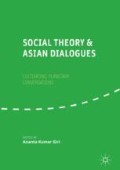Abstract
In the Indic perspective, the notion of the self operates very differently from the understanding of individuality that exoteric monotheisms and modernist ideologies propose. The shortest of the Upanishads, Isha, contains a proclamation known as a mahavakya, or great saying: “So ham asmi.” Other such Upanishadic sayings include “I am that” or “I am Brahman.” In these formulations the “I” expands into cosmic consciousness reaching a non-dual or advaitic awareness. When even this expanded “I” dissolves into the womb of Adyashakti, then the music of the spheres as the inner vibration or spanda can be heard in the human heart. It is the Buddha’s articulation of advaya that brings one into this profound voidness or shunyata of the Mother Ground. Examining the self/other dynamic within various philosophical debates, one recognizes how an encounter with a radical alterity saves us from an inflated ego leading to mahakaruna or great compassion. Then we dance with the other in profound maitri or friendliness in a world that is itself nirvana. This chapter examines these utterances from a broadly tantric Buddhist perspective so that the self as an imperial being can be overcome.
Access this chapter
Tax calculation will be finalised at checkout
Purchases are for personal use only
Notes
- 1.
I use Gynocentric with a capital G to denote Mother-centered Indic tantric paths of liberation.
- 2.
In my book, In the Beginning is Desire: Tracing Kali’s Footprints in Indian Literature, New Delhi: Indialog, 2004, I called the fierce goddess Kali “pregnant-nothingness” to capture the paradox of the Mother Principle.
- 3.
See Iain McGilchrist’s The Master and His Emissary: The Divided Brain and the Making of the Modern World 2009, New Haven: Yale UP, where he argues against “an excessive and misplaced rationalism” and “a relentless growth of self-consciousness, leading to increasing difficulties in cooperation,” which has shifted the balance of power dangerously toward the left brain (6–7).
- 4.
See Keith Dowman, Masters of Mahamudra: Songs and Histories of Eighty-four Buddhist Siddhas, Albany: SUNY, 1985, p. xii.
- 5.
Thomas Docherty, Postmodernism: A Reader, NY: Columbia UP, 1993.
- 6.
See Wes Avram, “On the priority of ‘ethics’ in the works of Levinas,” Journal of Religious Ethics, 24.2 (1996) 261–284.
- 7.
See “Ethics as First Philosophy” in The Continental Philosophy Reader, eds. Richard Kearney and Mara Rainwater, London: Routledge, 1996.
- 8.
See “Questions to Emmanuel Levinas” in The Irigaray Reader, ed. Margaret Whitford, Oxford: Basil Blackwell, 1991.
- 9.
See Neela Bhattacharya Saxena, Absent Mother God of the West: A Kali Lover’s Journey into Christianity and Judaism, Lanham: Lexington, 1216.
- 10.
Samuel Huntington, Clash of Civilizations.
- 11.
For a comprehensive reading of Indic traditions and thinkers see Nataliya Isayeva’s, From Early Vedanta to Kashmir Shaivism: Gaudapada, Bhartrihari and Abhinavagupta, Albany: SUNY Press, 1995.
- 12.
See Martin Buber, I and Thou, in a new Translation with prologue and notes by Walter Kaufman, NY: Touchstone, 1970.
- 13.
In an ongoing commentary on the Saundaryalahari and its erotic mysticism that many Indian traditions believe was written by Advaita Vedantin Shankaracharya, Swami Vyasaprasad argues that “Religious doctrines that discredit the value of nature do a great disservice to the dialectical relationship between man and woman. When nature is somehow considered ‘inferior’ to god, who is in turn thought of as male, the relationship between man and woman becomes lopsided.” In the Indic path though there is an “inclusive dialectic of ‘this and that’ rather than ‘this or that’ which ‘stems from deep understanding of the dialectical interdependence of the apparently polarized nature experienced as the world phenomena’” (http://vyasaprasad.blogspot.com/).
- 14.
See an interesting reading by Alfred Collins, “Dancing with Prakriti: The Samkhyan Goddess as Pativrata and Guru” in Is the Goddess a Feminist: The Politics of South Asian Goddesses, eds. Alf Hiltebeitel and Kathleen Erndl, NY: NYU Press, 2000.
- 15.
Eknath Easwaran calls Isha (which can be translated as God) as the Inner Ruler and therefore is a distinctly different notion from the exoteric reading of the Wholly Other of the Judaic tradition. In his commentary Eswaran writes: “no duality, not even that of non-being and being, death and life, is more fundamental than Reality, which is beyond all categories” (206).
- 16.
See The Concealed Art of the Soul: Theories of Self and Practices of Truth in Indian Ethics and Epistemology, Oxford: OUP, 2007.
- 17.
I am deeply indebted to my Guru Kulavadhuta Satpurananda for clarifying the difference.
- 18.
“The philosophy of Vajrayana Tantra is basically nature, science and truth codified; it reveals the secrets of existence in relation to the mind, body and spirit. Vajrayana Tantra teaches one how to be a natural human being in accordance with the cosmic rules of existence, it accentuates how to reach your full potential as a highly evolved being” (Satpurananda—teaching text).
- 19.
See “Religion, Ecology, and the Planetary Other: Opening Spaces for Difference,” JAAR Dec 15.
- 20.
Gayatri Chakravarty Spivak (2004), The Death of a Discipline, p. 72.
- 21.
There is a danger of seeing tantra as nothing but technology as these Dzogchen masters point out: “Outside of the womb-space of view and transmission, the dynamic and organic process of skillful means suffers a deadly reductionism into mechanical technique at the hands of constricting intellectualisms” (xiii). See Ngakpa Chogyam and Khandro Dechen’s Roaring Silence: Discovering the Mind of Dzogchen, Boston: Shambhala, 2002.
Reference
Buber, M. (1970). I and Thou: A New Translation, with a Prologue and Notes by Walter Kaufman. New York: Touchstone.
Author information
Authors and Affiliations
Editor information
Editors and Affiliations
Rights and permissions
Copyright information
© 2018 The Author(s)
About this chapter
Cite this chapter
Saxena, N.B. (2018). Iridescent Self in the Womb of the Wholly M(O)ther: A Vajrayani Meditation. In: Giri, A. (eds) Social Theory and Asian Dialogues. Palgrave Macmillan, Singapore. https://doi.org/10.1007/978-981-10-7095-2_7
Download citation
DOI: https://doi.org/10.1007/978-981-10-7095-2_7
Published:
Publisher Name: Palgrave Macmillan, Singapore
Print ISBN: 978-981-10-7094-5
Online ISBN: 978-981-10-7095-2
eBook Packages: Social SciencesSocial Sciences (R0)

